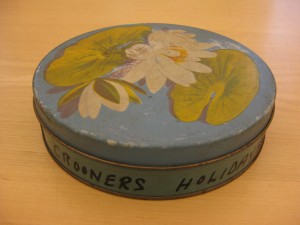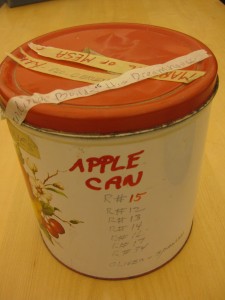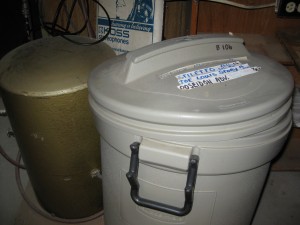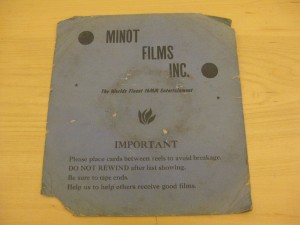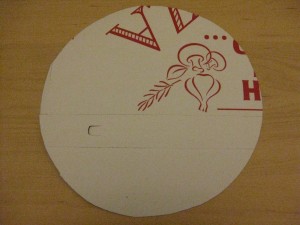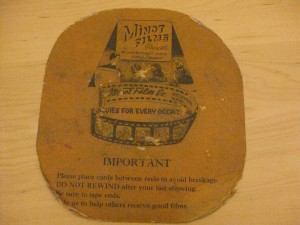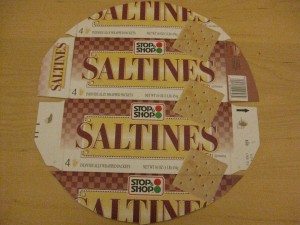scratch that
March 12th, 2012
Film is both sturdy and incredibly delicate. One wrong move can ruin a film forever. The biggest mistakes most often happen in projection. Like vampires, film projectors often destroy the ones they love.
The image above, seen through a loupe, is from a 16mm print that was most probably projected from or onto a bent metal reel that had a burr on it. This print of The Great John L. (USA, 1945) is from the Howard E. Burr Collection. (This is also the kind of scratching you can get from running a film on a platter incorrectly, but those of you projecting at home probably won’t have to worry about that.)
The image above, from another print of the same film, shows damage that can be done inside the projector gate. There is a short white line through the man’s head in this Gone With the Wind – style shot. This is where the emulsion has been abraded, probably by something stuck to the gate.
The arrows point to another emulsion scratch. This could easily have been made by a dirty roller in the projector.
Always clean your projector prior to showing your movie! Here are some tips on projector cleaning from Bob Brodsky.
A film container is something you keep film in.
June 24th, 2011
Here at the Harvard Film Archive, we store motion picture films in inert, polypropylene film cans on cores made of the same plastic. The cans provide protection in case of a water event, and are vented to give the film some breathing room. The cans are round discs, like the film rolls that are housed inside.
When film arrives at the archive, however, it doesn’t always arrive in what we consider a proper film can. (Cookie tins are suprisingly popular among collectors!) What follows is an image gallery of unusual film containers that have arrived at the HFA over the past few years.
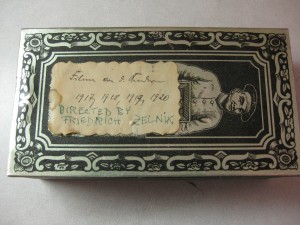
This film was not donated to the archive, but was brought in by a patron. It was stored in this box for decades.
another curiosity from the Burr collection
March 16th, 2011
Howard Burr stored his large film collection in whatever containers were handy. Film shipping boxes are not such an unusual choice, but what about trash cans? Between each reel inside the trash cans, he put a piece of cardboard, cut from whatever was handy. What follows is only a small percentage of the cardboard discs we found.
The films don’t seem to have suffered ill-effects from being stored with the cardboard, which probably absorbed some humidity before it could harm the film.
Unidentified Film Stills
September 22nd, 2009
Here are some film stills from the Burr Collection which are presently unidentified. Today I write asking for you to take an active role in the blog.
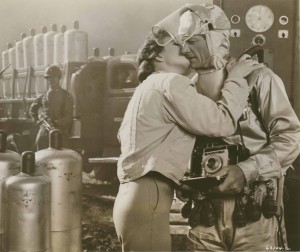
photo 1 - The Black Scorpion (1957) tagline DON'T BE ASHAMED TO SCREAM - IT HELPS TO RELIEVE THE TENSION
Here is the exciting text that accompanies the above image:
Heavy equipment is brought up and Hank and Ramos agree to be lowered in a cage to investigate. Teresa is terrified, for she and Hank have developed much more than a friendly relationship toward one another.
Unknown to everyone, Juanito has hidden himself in the cage. At the bottom of the chasm, Juanito waits until the men are out of sight, then he wanders off by himself. The little tot has decided that grown men need his help. Hank and Ramos find only the searcher’s hat and figure he fell into a pool of molten lava. Suddenly they halt in their tracks as they hear human screams.
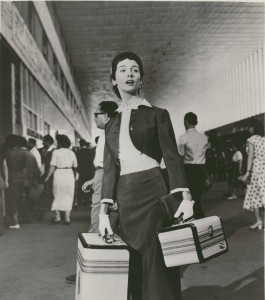
photo 2 - Three Coins in the Fountain
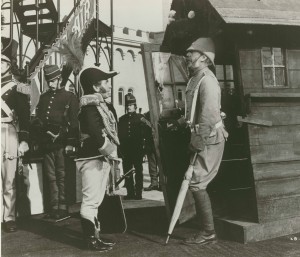
photo 3 - Chitty Chitty Bang Bang
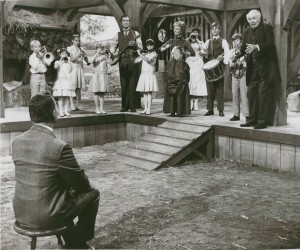
photo 4 - The One and Only, Genuine, Original Family Band
The following are from the same film.
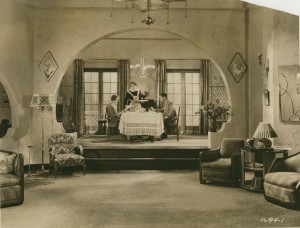
photo 5 - Extravagance (1930)
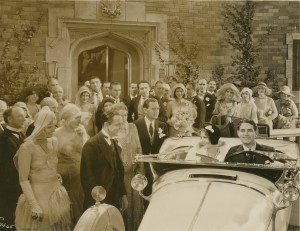
photo 6 - Extravagance (1930)
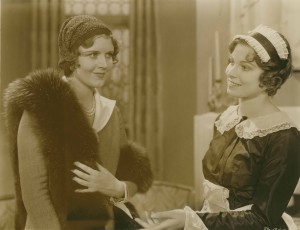
photo 7 - Extravagance (1930)

photo 8 - Extravagance (1930)
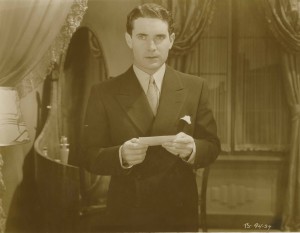
photo 9 - Extravagance (1930)

photo 10 - Extravagance (1930)
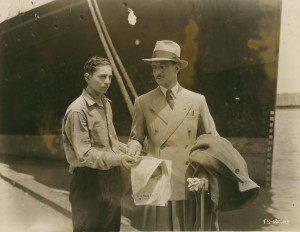
photo 11 - Extravagance (1930)
NHF Summer Symposium
August 31st, 2009
Last month the HFA’s Conservation Center staff attended the annual Summer Symposium at Northeast Historic Film in Bucksport, ME. The theme of this year’s symposium was Ways of Watching.
Papers were delivered on topics as diverse as watching and interpreting the home movies of strangers, presenting films at a department store in the early days of cinema, and viewing films in classrooms.
This was a great opportunity for the HFA to present some films from the Howard E. Burr Collection. We realized that, although the scholars and archivists at the symposium were very interested in watching films, some may not have ever seen a film projected, as many researchers access film through digital or video copies of the actual film. Most had probably not watched films at the home of a collector, and many had probably not seen the films I chose to project for them.
We decided to set up a screening night that would roughly represent a typical screening night in the home of a film collector. We didn’t want the screening to take place at the same venue as the symposium, which was held in NHF’s movie theatre, because the nature of the event demanded a more intimate atmosphere. A local participant in the symposium generously volunteered to host the screening at her home, which was perfect.
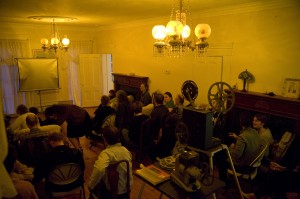
Not all collectors present their screenings in the same way, but there tends to be a common wish to “put on a show,” frequently aping the habits of the cinema during Hollywood’s Golden Age. Rare is the screening of only one title. “Doc” Burr’s daughter described screening nights at his home, which represent the habits of many others: “He was big on showing newsreels, a travelogue, previews of coming attractions, or cartoons (sometimes one of each!) preceding the feature.” For the NHF screening night we attempted a similar program (although far shorter).
We presented film on 3 small gauge formats common to the US home cinema market: 16mm, 8mm, and super 8. First, an 8mm reduction print of a silent Mack Sennett comedy, The Campus Carmen (1928). Next up, New England Holiday!, a 16mm short, silent travelogue from the 1940s about vacationing in New England. In keeping with tradition, we moved to a cartoon, Farmer Gray in English Channel Swim (1925), shown in 16mm. The “feature” finale was a super 8 condensed reduction print of Taxi Driver (1976), with mag sound.
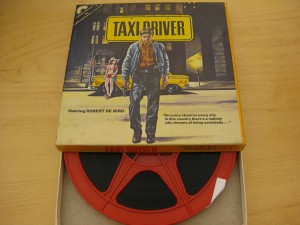 It was not unusual for studios to release condensed versions of features for the home market. Most common are the 8mm or super 8 silent versions that take a feature film and reduce it to its best 5 minutes, using inter-titles to explain the story.
It was not unusual for studios to release condensed versions of features for the home market. Most common are the 8mm or super 8 silent versions that take a feature film and reduce it to its best 5 minutes, using inter-titles to explain the story.
This version of Taxi Driver was a little different. The tale was cut down to the story of Travis, the pimp, and Iris (the teenage prostitute). A narrator is employed to describe some gaps in the story. “Travis Bickle has decided to take revenge against the pimp.” The original sound from the film is retained. “You lookin’ at me?” Using only the scenes of sex and violence, the film is reduced to an exploitation version of itself.
The screening was a perfect coda to the symposium. Everyone welcomed the opportunity to sit and watch films projected from a few feet behind them, the unfamiliar noise of the projector becoming part of the show. People who were not familiar with these “home versions” of feature films were fascinated by them. The woman who had not seen Taxi Driver had her fears confirmed, but has lived to tell the tale.
Upon returning home, we discovered quite a number of these super 8 sound condensed films, and hope to put a screening together for the public. Keep an eye on our calender for details.

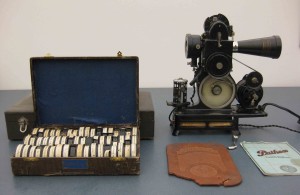
This is the 9.5mm Pathé Baby projector and film (reduction prints).
9.5mm, a safety stock (not flammable) developed for home use, was invented in France in 1922, pre-dating the familiar 16mm gauge by one year. Previously, Pathé had offered a safety stock on 28mm, which proved too expensive to see widespread use. 9.5mm took off, becoming extremely popular in Europe where it is still used to this day by amateur filmmakers. 9.5mm was sold in the USA as well, but 16mm proved to be more commonly used by North Americans, which is why many of us have never heard of 9.5mm film.

As you can see in this image, the 9.5mm gauge features a perforation between the frames instead of along the side (which is the standard for all other film gauges used today). This affords greater real estate for the image, as leaving space along the edge for the perforation is not necessary. This narrow film has the image area almost as big as 16mm.
9.5mm was an early amateur film stock, used by people to make home movies. Pathé initially included instructions and equipment for developing the film at home as well, but difficulty in achieving consistent results led most people to send it away for processing.
The glassed-in circle at the bottom of the projector is an enclosed film take-up area. The projector can play two sizes of film cartridges, lengths of 8.5 meters or 20 meters.

The films in this box are reduction prints of French, English, and American condensed films, sold in France. The projector features a mechanism which stops the film for a few seconds when it is signaled to do so by a notch on the edge of the film. This was employed for commercial films, freezing the film on a title card, saving precious film stock for moving image instead of using it up making longer title cards.
For more information on 9.5mm and the long history of home movie technology, see Alan Kattelle’s exhaustive book on the subject, Home Movies (Nashua: Transition Publishing, 2000.)

Burr Collection Fan Magazines
May 11th, 2009

Film Fun Magazine
The Howard E. Burr Collection contains not only film, equipment, lobby cards and posters, but also a variety of movie magazines.
Collector “Doc” Burr built up large holdings in Photoplay, a classic of film fandom, and he was, of course, a serious collector of film collector catalogs such as The Big Reel, Blackhawk, and other lesser known publications aimed at the amateur film collector.
His legacy of fan magazines is less than complete, with few titles demonstrating any kind of serious attention; taken as a whole, it’s fascinating. Over 50 titles are represented, dating from the 1920-1980s, the majority dating from the 1960s & 70s.
The magazine titles are often similar; sometimes their names have changed a bit with the addition of TV reporting. Some titles existed for decades, some for only a year or two. Titles containing Movie or Screen were particularly popular, as evidenced by this lists from the collection: Movie, Movie Life, Movie Mirror, Movie Stars, Movie TV Secrets, Movie World, Movieland , Movieland and TV Time, Screen, Screen Album, Screen Hits, Screen Life, Screen Mirror, Screen Stars, Screen Stories, Screenland, Screenplay, Photo Screen, Silver Screen, Modern Screen, TV & Screen World.

Fan Magazines Featuring Elizabeth Taylor
The attention paid to Liz Taylor and Jackie Kennedy Onassis (her lack of movie star status didn’t stop her from making the cover of countless issues) is stunning. The gossip, the scandals and the advertising all add up to capture the spirit of fandom in a unique way. Fascinating time capsules, the magazines feature advertisements advising women to put on weight. The most serious star scandals involve affairs not sanctioned by marriage, and the “male nudity craze” makes front page news.
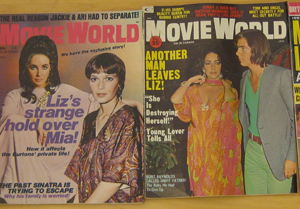
Elizabeth Taylor on the cover of Movie World magazine
Basement Cache
May 7th, 2009
The Harvard Film Archive has over 15,000 films in our collection. Sometimes we acquire films one by one, sometimes we are given small collections, and sometimes we acquire large collections all at once. We open the HFA blog with the announcement of a large collection we are in the opening stages of acquiring, the Howard E. Burr Collection.
In the years before home video, cinefiles bought copies of films on film. The studios distributed films on non-theatrical film sizes for use in the home. These prints were made on safety stock, not the flammable nitrate used in cinemas. The highest quality (and most expensive) copies were on 16mm. Cheaper (usually condensed) versions of features were distributed on 8mm and, later, on Super, usually silent versions with intertitles like a traditional silent film.
Howard E. “Doc” Burr collected film his entire life. In his professional life, he was a dentist, but when he got home, his passion was clearly cinematic. He watched at least one film a day. He put on shows for his family and their friends. In the summer, shows would be put on outside, projected on a sheet for his family and the kids of the neighborhood.
When Doc died this year at age 89, he left behind a basement devoted to his passion. He had collected film for over 80 years, having begun as a child. He collected feature films, mostly Hollywood productions, as well as short films (comedies, dramas, documentaries, sports films, educational films), silent films, westerns. As many collectors of his generation did, he had a fondness for the like of Abbot and Costello, Laurel and Hardy.
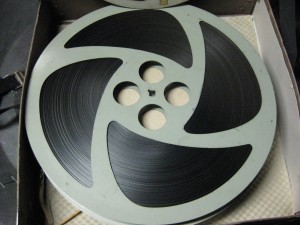
A reel of film from the Burr Collection
He built a little movie theatre in the basement of his ranch-style home in Western Massachusetts, with movie posters decorating the wood paneled walls. There was a projection booth with 35mm and 16mm projection, and an 8mm projector in front of the booth. At the other end of the room a movie screen took up the entire wall. A green curtain in front of the screen was motorized, controlled from the booth. The projectionist (Doc) would open the curtains before the show, like in an old-fashioned theatre. Most programs included a variety of films in the old theatrical style: cartoons and shorts would precede the feature.
The rest of the basement was devoted to the storage of projectors and movies. The film storage room was packed with all sizes of film, totaling well over 2,000 features and shorts. Doc had a complex but very accurate method of keeping track of the location of each film. He had extensive inventories and notes about his films and equipment, all of which is coming to the archive with the collection. He had a card catalog as well as many notebooks devoted to his collection. Sometimes he kept a guest book, and audience members signed in, making comments about the films they were treated to.
Although film collecting was once quite common, Dr. Burr’s collection is unusually large. His breed is dying out, as younger cinefiles prefer the smaller, less expensive, more user-friendly format of DVD. The Harvard Film Archive is very pleased to be able to keep this remarkable collection together. It represents not only a great collection of film, but also a fascinating look into the habits of a film collector. We are accepting into our collection not only the films, but also many of the projectors and the paper ephemera Dr. Burr collected to complement his film cache. He amassed lobby cards and film posters, movie magazines and books, collector newsletters, and, most fascinating to the HFA’s conservation staff, all the correspondence and paperwork that was necessary to build his collection. Being a film collector meant trading through the mail, and he saved letters, receipts, lists, canceled checks and all kinds of notes regarding not only the selling and trading of films, but also everything related to his equipment. This collection provides a fascinating resource for anyone studying film collectors.
We will continue to explore this collection through this blog, as we discover new themes and interesting little gems.





